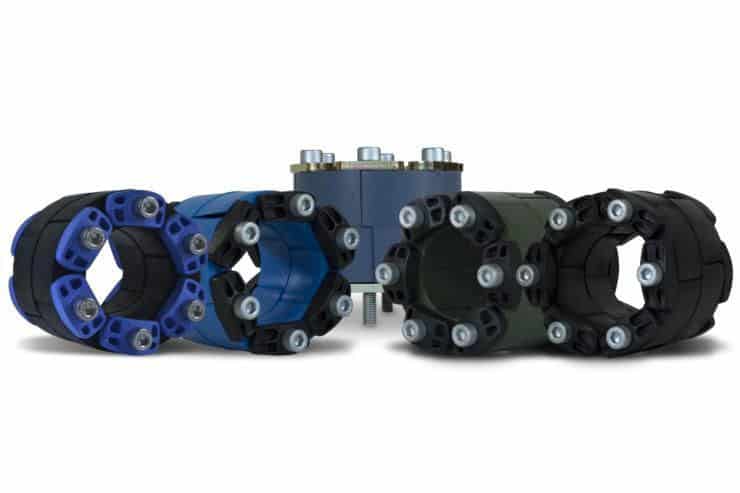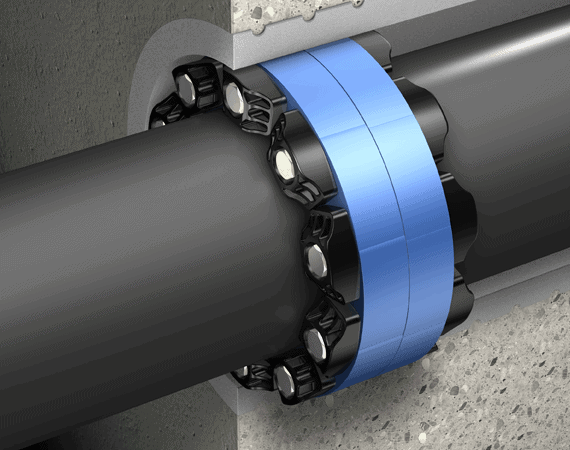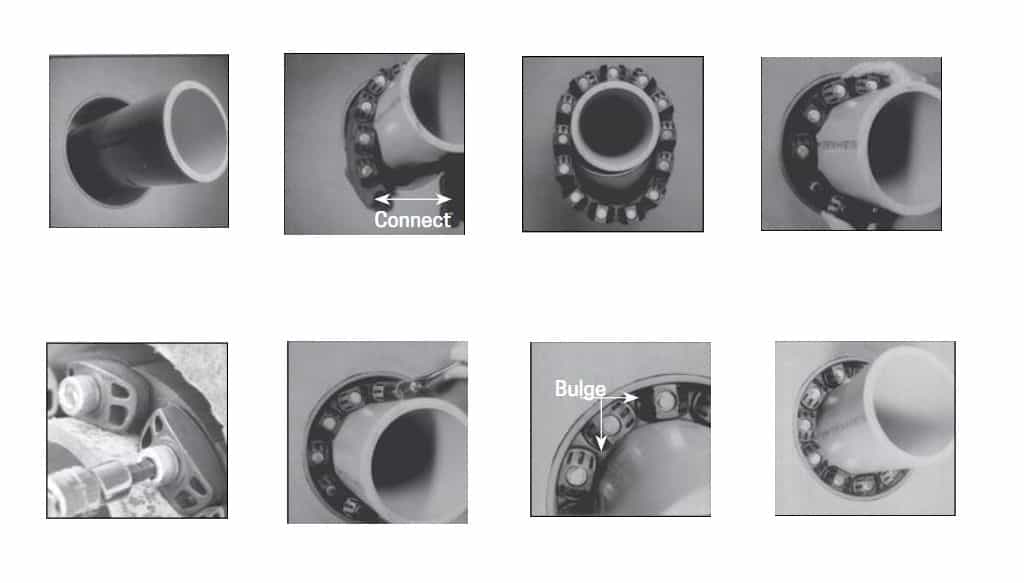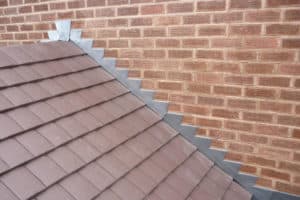One of the ways to reliably seal the annular space between the carrier pipe and the core hole is the product known as a link seal.
What is a Link Seal? A link seal is a flexible belt composed of rubber links used for sealing pipe penetrations in concrete walls, floors, and ceilings. It fits between a pipe and a round wall to seal the pipe and form a safe hydrostatic seal.
The seal created is capable of withstanding high pressure and provides a maintenance-free service for at least 40 years.
Link-seal improves overall system reliability by reducing the damaging effects of vibrations on the pipe, and on the pipe welds, flanges, and threaded connections. Link seal has now entered its 4th generation of refinement and is offered in various types and sizes. Link seals are made in the USA with 100% domestic content and are AIS Certified.
To learn about the best methods in residential plumbing, check out this article on trenchless sewer repair.
What Are Link Seals Used For?
Link seals are modular seals used for sealing pipes or any other cylindrical object passing through floors, walls, and ceilings. They are simply wrapped around the pipe and expanded the rubber to form a hydrostatic seal against the entry of water, oil, or backfill material.

All link seals are watertight. The way the link seal gets to be watertight is in the way it is constructed. As you tighten the bolts on the belt one-by-one the compression expands the rubber, and the links enlarge transforming the belt of separate links into a reliable hydrostatic seal.
This hydrostatic seal formed by the belt is capable of holding over 20 PSIG but has been tested in the laboratory under controlled conditions to 100psig. This makes link seals a great option for pipe penetration sealing.
Additionally, the carbon steel bolts and nuts offer excellent corrosion resistance and are salt spray tested for 1000 hours.
The main benefits of link seals are:
- Positive hydrostatic seal rated at 20psig
- Long seal life of up to 40+ years
- Quick to install, and can save you money
- Protects against corrosion
- Can protect against fire with Model T
- Increased vibration dampening
How to Size a Link Seal?
The easiest way to properly size a link seal you need to follow the steps provided in the link seal chart (from GPT), Trumbull MFG, or PVC Fittings Online.
Before ordering a link seal you need to know your pipe size and the type of pipe material. Other than that you should know your link seal model, type of sleeve or hole, and the sleeve length. The link seal sizing charts I provided here will help you do that.
How to order link seal?
As mentioned above, you need to know about the pipe in question, the model for the seal, and a few other factors.
Here are the steps from the link seal ordering guide from GPT:
- Determine your Link seal model from this Engineering manual
- Locate charts on pages 6-9 that fits the type and size of the pipe
- Verify that your pipe O.D. matches the actual outside diameter shown on the chart
- Choose the link seal size, seal model, and links required per seal
- Finally, you can either contact a distributor in your area or visit this link seal calculator after which you can enter your zip code and get a list of distributors in your area.
Link seal is available worldwide, so you can order it from wherever you are.

One great thing about link seals is that they are nicely packaged and ready to be used right out of the box. With some tightening, you can place this pipe seal fairly quickly if you follow the instructions provided.
What Kind of Link Seal Models Are There?
Link seal is offered in many types to fit all needs depending on the conditions and the pipe in question. Here are the types of link seals models from GPT:
- Model “C” – (black) EPDM link seals are the standard type, used in water direct ground burial and normal atmospheric conditions. Standard type.
- Model “S-316” – (black) EPDM for chemical processing and wastewater treatment. Type stainless.
- Model “L” – blue Low Durometer EPDM for use with fragile pipe and tubing. Type standard.
- Model “LS-316” – (blue) EPDM Low Durometer for fragile pipes, for use in chemical processing and wastewater treatment. Type stainless.
- Model “O” – (green) Nitrile resistant to oils, fuel, and many solvents. Type: oil resistant.
- Model “OS-316” – (green) Nitrile combination of oil-resistant rubber and stainless steel hardware. Type: oil resistant.
- Model “T” – (grey) Silicone for temperature extremes or fire rated walls. Type: high/low temperature
- Models “FD & FS” – (grey) Silicone, double seal for added protection. Type: Fire Seals.
- Model “S61” – (black) EPDM for use in drinking water. Type: stainless
You can read more on the types of link seals models from the GPT manual (page 6).
How to Install a Link Seal?
When your link seals get delivered, they’re immediately ready for installation because they’re conveniently packaged. Keep in mind that link seals aren’t intended to support the weight of the pipe – it should be used as intended, as a penetration seal.
Here are 5 simple steps to installing a link seal:
- First, you can tighten the bolts just enough to give the belt some needed stability.
- Next, measure how many links you need by wrapping it around the pipe, and making sure the bolts are facing you so you’ll be able to tighten them.
- Connect the first and last link on the belt. Some axial misalignment is allowed, though try to make sure the pipe is centered. Also, extra slack or slag is normal.
- Start a tightening sequence by moving clockwise along the seal, and tightening each bolt 2-3 turns at each pass. Usually, two to three passes are needed to complete the tightening process.
- When the rubber links swell or bulge around the pressure plates the installation is complete.

A few things to remember when installing a link seal:
- seal assembly and pipe shouldn’t be dirty before starting
- make sure not to torque each bolt completely before moving on to the next
- don’t use high-speed power tools, and for type 316 don’t use power tools at all
- for tight fits, you can use non-polluting liquid detergent to assist installation
- don’t use grease when installing link-seal
Here are instructions in the video form by GPT on how to install link seals:
How to tighten link seal?
Once the link seal is placed between the pipe and the round wall, you can start a tightening sequence.
Tighten using a hand socket or off-set wrench only. Tighten each bolt 2-3 times moving clockwise, and finishing about 2 or 3 rotations until the links have been uniformly compressed and created a seal.
Once the rubbers links bulge around all pressure plates the installation is complete.
Are Link Seals Fire Rated?
Not all link seals are fire-rated, except Model T, though most of them are built for the temperature ranges of -40° to +250°F (or -40° to +121°C).
Model “T” – (grey) Silicone is fire rated link seal specially designed for temperature extremes or fire rated walls. The “T” model is one-hour Factory Mutual approved, which means that it can be used as a 1-hour fire stop. It can handle temperature ranges of between -67° to +400°F or -55° to +204°C.
It can sustain constant temperatures of 325°F (163°C) and can protect against flames at temperatures as high as 1,900°F (1,038°C).
There are also models FD & FS, which are essentially two T Models back-to-back for added protection. It’s a double seal (dual belt) that can withstand the same temperatures as the model T.

Who Makes Link Seal?
Link seal is manufactured by GPT Industries (formerly PSI/Thunderline).
Link seal was created by Thunderline Corporation, which was later acquired by PSI, and now merged with Garlock to become GPT – and EnPro Industries Company.
Link-seal distributors
One of the main distributors of link seal is Trumbull Mfg. You can find link-seal distributors in your area by using the newly updated link seal Finder. GPT Industries supplies link seals worldwide.
Link-seal price
Link seal price varies depending on your distributor and the shop. For example, if you were to search for seal links to buy online you’d get variable prices per link.
I say “per link” because link seals are sold as individual links in these shops, which you need to connect to form a seal around the pipe.
On PVC Fittings Online the price is anywhere from $2.84 to $36.40 per link, depending on the model and the size. On PVC Pipe Supplies it’s anywhere from $4.99 to $37.99.
Being a master distributor of link seals, here’s a Trumbull Mfg link-seal catalog. Feel free to learn more about link-seal from the resources below.
Resources:







![How Much Do Shipping Containers Cost? [Full Guide] Shipping Container retail shop (cost)](https://howmonk.com/wp-content/uploads/2020/03/Shipping-Container-retail-shop-300x200.jpg)



![How Long to Wait Before Mowing New Grass? [Guide + FAQs]](https://howmonk.com/wp-content/uploads/2022/06/push-mower-cutting-grass-on-lawn-230x200.jpg)
